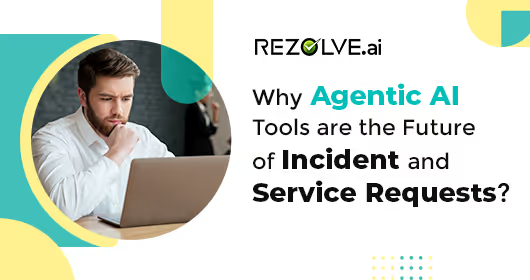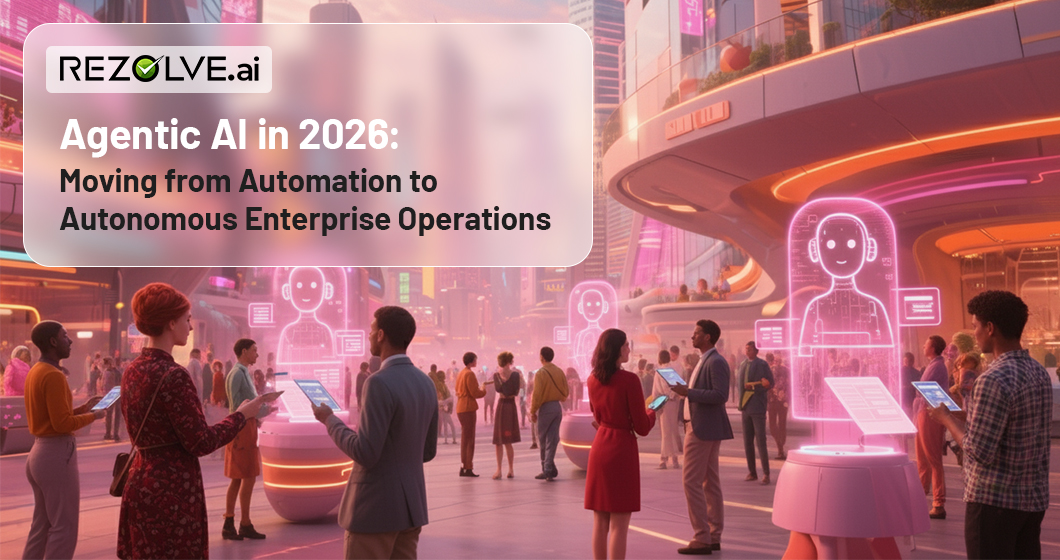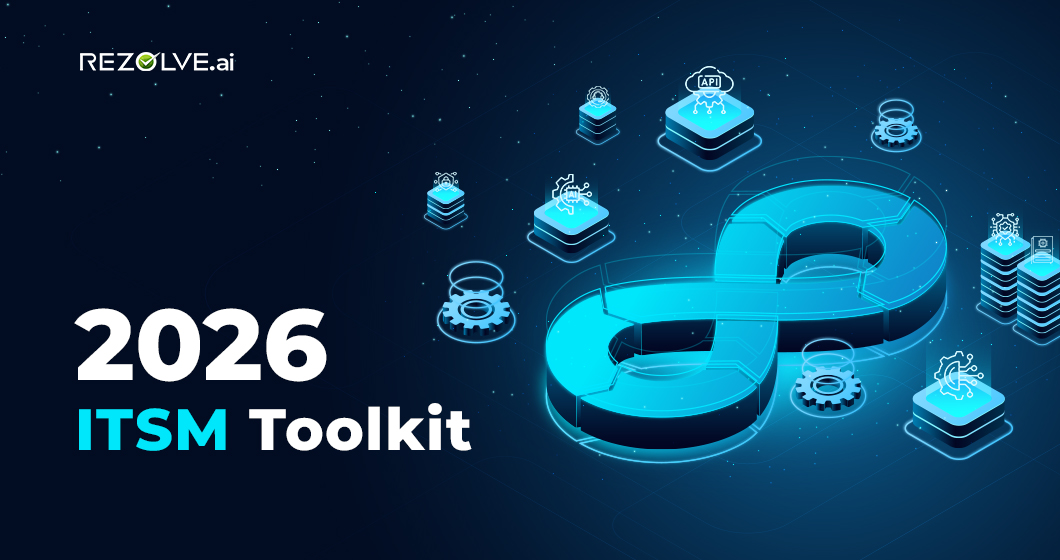IT teams are always drowning in tickets. From password resets to network failures, the sheer volume of incidents and service requests is overwhelming. Manual handling slows things down, rule-based automation lacks flexibility, and customers? They just want their issues solved—fast.
Traditional ITSM models weren’t built for today’s speed. They rely on static workflows, predefined escalation paths, and human decision-making at every step. The result? Delays, inefficiencies, and frustrated users.
Enter Agentic AI—a game-changer in IT service management. Unlike conventional AI, which reacts to commands, Agentic AI is autonomous, proactive, and self-improving. It doesn’t just process tickets—it resolves them intelligently. It learns, adapts, and even prevents issues before they happen. This is more than an upgrade; it’s a revolution in how IT services function.
Understanding Agentic AI
.avif)
At its core, Agentic AI refers to AI-driven systems that can operate independently, make real-time decisions, and take actions without constant human oversight. These AI agents are designed to mimic human cognitive processes—observing, learning, reasoning, and executing tasks dynamically.
Unlike traditional AI, which follows pre-programmed logic, Agentic AI is:
- Autonomous – Works independently without human intervention.
- Proactive – Anticipates issues and resolves them before they escalate.
- Adaptive – Learns from every interaction and continuously improves its decision-making.
Think of a smart IT helpdesk agent that doesn’t just register tickets but also diagnoses the problem, finds solutions, and resolves the issue autonomously—without waiting for a human to intervene.
What is Agentic AI and Why Does It Matter?
Agentic AI refers to autonomous AI systems that proactively detect, diagnose, and resolve IT issues without human intervention. Unlike traditional AI, which waits for instructions, Agentic AI takes action—learning from data, adapting in real time, and preventing future problems. It transforms IT service management from reactive to proactive, improving speed, efficiency, and user satisfaction
Real-world Examples of Agentic AI in Action
.avif)
- Automated IT Support: AI agents in Microsoft Teams proactively detect system errors and fix them before users notice.
- Self-Healing Networks: AI-driven infrastructure that automatically reroutes traffic when a server is under heavy load.
- Cybersecurity Response: AI systems that detect and isolate threats before they cause widespread damage.
These AI-powered systems aren’t just supporting IT teams—they’re taking over the heavy lifting, ensuring faster, more reliable service management.
Case Snippet
A leading restaurant chain transformed its IT support by deploying an agentic AI-powered virtual assistant that automated routine service requests and endpoint troubleshooting. By reducing after-hours IT support calls from 90% to just 10%, the company empowered employees with self-service while significantly cutting response times and freeing IT teams to focus on critical business needs.
Transforming Incident and Service Request Management
Let’s see how incident and service request management have evolved with the Agentic AI wave. But first, let us clarify the key differences between these two types of requests.
Difference Between Incident and Service Request
.avif)
While both incident and service request are fundamental to IT service management (ITSM), they address different types of user needs.
An incident is an unplanned disruption or failure in IT services that impacts business operations. This includes system crashes, network failures, application errors, or security breaches—anything that requires immediate attention to restore normal functionality. For example, if a company’s email server goes down, it’s an incident that needs urgent resolution.
A service request, on the other hand, is a standard user request for access, information, or minor changes that don’t indicate a failure. These are pre-approved, repeatable requests like password resets, software installations, or new device provisioning. Unlike incidents, service requests follow a structured workflow, often managed through an ITSM platform.
Understanding the difference between incident and service request is crucial for IT teams to prioritize issues effectively. Incidents demand immediate resolution, while service requests can be processed through automation or a structured approval system. With Agentic AI, businesses can automate both, ensuring faster resolution times and seamless IT service management.
From Ticketing Chaos to Intelligent Resolution
For decades, ITSM has relied on ticket-based models. A user submits a request, it gets queued, assigned, and eventually resolved—often taking hours or even days. In a world where businesses expect real-time solutions, this outdated approach simply doesn’t cut it.
The Shift Towards AI & Automation
To speed things up, companies turned to automation and AI-driven ticketing systems. Chatbots and workflow automation reduced manual effort, but these tools had serious limitations:
- They followed predefined scripts. If a request didn’t match a known scenario, escalation was required.
- They lacked real problem-solving abilities. AI chatbots could answer FAQs but couldn’t troubleshoot deep technical issues.
- They couldn’t handle context. If a user had a complex problem, bots couldn’t analyze past tickets, user history, or system logs to offer a resolution.
That’s where Agentic AI breaks the cycle. Unlike static automation, it learns, adapts, and makes decisions dynamically eliminating bottlenecks and manual intervention.
How Rezolve.ai’s Agentic AI Redefines Incident and Service Request Management
.avif)
Agentic AI based solutions, like Rezolve.ai, don’t just automate tasks—it transforms the entire service request lifecycle. Here’s how:
1. Autonomous Issue Resolution
Imagine an employee facing a VPN connectivity issue. Traditionally, they’d submit a ticket and wait for an IT admin. With Agentic AI, the AI agent detects the problem, diagnoses it, and executes a fix instantly. No waiting. No escalation. Just an immediate resolution.
2. Contextual Understanding
Unlike basic automation, Agentic AI analyzes logs, historical incidents, and user behavior to understand the full context of an issue.
Example: A server crash isn’t just treated as an isolated issue. The AI examines past patterns, predicts possible causes, and executes preventive measures to stop future crashes.
3. Dynamic Prioritization & Routing
Not all tickets are created equal. An entire network outage should be addressed faster than a printer issue, yet traditional systems lack real-time prioritization.
Agentic AI assesses urgency, business impact, and risk factors, ensuring that critical issues get top priority. If a high-priority security alert is detected, it bypasses standard queues and triggers an immediate response.
4. End-to-End Automation
From ticket creation to resolution, Agentic AI manages the entire lifecycle. Instead of IT teams spending time manually routing tickets or searching for solutions, AI executes fixes in real-time, self-learns from past incidents, and continuously optimizes processes.
This isn’t just automation—it’s intelligent execution that improves itself over time.
Expert Quote
“In a world where business moves at digital speed, Agentic AI shifts IT service management from reactive firefighting to intelligent, autonomous problem-solving. With Rezolve.ai, enterprises can deliver instant, always-on support while freeing IT teams to focus on innovation.”
— Manish Sharma, Chief Revenue Officer, Rezolve.ai
Advantages and Benefits of Agentic AI in ITSM
Adopting Agentic AI isn’t just about efficiency—it redefines how IT teams operate, bringing tangible benefits that transform service management.
1. Reduced Human Effort & Costs
Routine password resets, software installations, and access requests no longer need human intervention. AI agents handle them autonomously, freeing IT teams for high-value work like cybersecurity, infrastructure improvements, and strategic planning. Organizations can cut down up to 50% of IT helpdesk costs, allowing teams to focus on innovation instead of routine tickets.
2. Faster Response & Resolution Times
Agentic AI eliminates waiting periods by taking instant action. Whether it’s a software crash, network downtime, or system configuration issue—AI resolves it in seconds, not hours.
Example: A company implementing AI-powered self-healing infrastructure saw a 90% reduction in downtime-related tickets within a year.
3. Enhanced User Experience
Nobody likes waiting on hold or explaining the same issue multiple times. With Agentic AI, employees get real-time, conversational support within tools like Microsoft Teams, Slack, or enterprise chat systems. User satisfaction scores can elevate greatly as AI delivers seamless, instant problem resolution without unnecessary back-and-forth.
4. Proactive IT Management
Most ITSM models are reactive—fixing issues after they occur. Agentic AI flips this model to proactive and predictive IT management.
Example: An AI system monitoring server performance detects anomalies and automatically adjusts resources before a slowdown happens—eliminating outages before users notice.
5. Scalability & Adaptability
As businesses grow, so do their IT demands. Scaling traditional service management requires more agents, more workflows, and more complexity.
Agentic AI scales effortlessly, adapting to new IT environments, security policies, and workflows without human intervention. Whether an enterprise is expanding its workforce or integrating new systems, AI adjusts in real-time.
Companies reduce the need for scaling IT headcount, handling 3X the number of service requests without additional overhead.
Use Cases of Agentic AI in Incident and Service Requests
.avif)
1. Automated Password Resets & Account Unlocks
Anyone working in IT knows this pain: password resets account for up to 30-50% of all service desk requests. Traditional ticket-based handling is a waste of IT resources, not to mention frustrating for employees who just need quick access.
Agentic AI Solution: Instead of routing these requests to human agents, AI-powered virtual assistants can instantly verify user identity and reset passwords autonomously—without manual intervention.
2. Self-Healing IT Infrastructure
What if IT issues could be solved before employees even notice them? That’s the promise of self-healing IT systems, where AI detects anomalies, diagnoses root causes, and applies fixes—all autonomously.
Agentic AI Solution: AI-powered monitoring agents scan network health, predict potential failures, and deploy automated fixes.
Example: Imagine a database server running low on memory. Instead of triggering a panic, the AI detects the trend, optimizes resource allocation, and prevents system crashes—all without human intervention.
Modern AITSM solutions like Rezolve.ai's Agentic AI 3.0 are designed to detect infrastructure vulnerabilities and take corrective actions in real-time, ensuring seamless uptime for businesses.
3. Proactive Cybersecurity Threat Response
Cyber threats are evolving faster than ever, and traditional reactive security measures aren’t enough. Modern cyberattacks require proactive AI-driven defense mechanisms. Here, an Agentic AI solution can identify potential threats, isolate compromised systems, and initiate auto-remediation protocols before attackers cause damage.
4. Smart Helpdesk & Virtual Agents in Microsoft Teams, Slack, or Workplace
Gone are the days of clunky helpdesk portals where users submit a ticket and wait hours (or days) for a response. AI-powered helpdesks inside collaboration platforms bring IT support to where employees already work.
Agentic AI Solution: Employees can get real-time, conversational support within Microsoft Teams, Slack, or Workplace—no need to log tickets manually.
Example: A global enterprise replaced its traditional ITSM portal with Rezolve.ai’s conversational AI inside Microsoft Teams, reducing ticket resolution time by 65% while increasing employee satisfaction.
5. Predictive Maintenance for Hardware & Networks
Equipment failures cost companies millions in downtime and repairs. Predictive maintenance ensures hardware failures are prevented before they happen.
Agentic AI Solution: AI continuously monitors hardware performance, predicts potential failures, and schedules maintenance before breakdowns occur. Rezolve.ai’s Agentic AI 3.0 is built to analyze real-time data, predict potential failures, and ensure seamless IT infrastructure performance.
Challenges & Considerations for Implementing Agentic AI
While Agentic AI is a game-changer, it’s not a plug-and-play solution. Enterprises must navigate key challenges to ensure a smooth transition.
1. Integration with Legacy ITSM Platforms
Many enterprises still use legacy ticketing systems that weren’t designed for AI-driven automation. A major roadblock is compatibility with existing ITSM tools like ServiceNow, Jira, or BMC Helix. Businesses must choose flexible AI solutions like Rezolve.ai that integrate seamlessly with existing IT ecosystems.
2. Data Privacy & Security Concerns
With AI handling sensitive IT and employee data, security is a top priority. Enterprises must ensure AI systems comply with GDPR, HIPAA, and other data privacy regulations. AI platforms should have role-based access controls, encryption, and robust compliance measures to safeguard data.
3. Change Management & Workforce Upskilling
AI adoption often meets resistance from IT teams fearing job loss or employees skeptical of AI handling IT requests. Instead of replacing jobs, Agentic AI augments IT teams, allowing them to focus on complex, strategic work rather than routine tasks.
4. Balancing Autonomy with Human Oversight
AI must be smart enough to act independently but also accountable. No enterprise wants an AI system that makes unchecked changes without IT visibility. Platforms like Rezolve.ai’s Agentic AI 3.0 provide customizable autonomy settings, allowing IT teams to set guardrails while benefiting from AI-driven efficiencies.
The Future of Agentic AI in Service Management
.avif)
Agentic AI isn’t stopping at incident and service requests—it’s expanding into enterprise-wide automation.
1. Beyond ITSM: Expanding into HR, Finance, and Customer Support
Agentic AI is already reshaping HR automation (onboarding, payroll issues) and customer support workflows (AI-driven self-service portals). E.g., enterprises are integrating AI-powered HR chatbots into Microsoft Teams to answer HR-related queries instantly.
2. AI Agents as Digital Co-workers in Enterprises
The next evolution? AI agents that collaborate with human teams. Instead of IT teams manually digging through logs, AI agents will proactively suggest optimizations and execute tasks.
3. Hyper-Personalization in IT Service Management
Imagine IT support that knows your preferences, work habits, and historical issues—offering tailored solutions instantly. AI-driven personalization will ensure service desks provide a custom support experience for each employee.
4. The Road Ahead – Agentic AI + Generative AI for Ultimate Autonomy
Agentic AI is evolving beyond automated execution—it’s merging with Generative AI to deliver:
- Automated root cause analysis reports.
- AI-generated service blueprints to optimize IT processes.
- Conversational GenAI agents that solve complex enterprise challenges.
With modern AI solutions like Rezolve.ai’s next-gen Agentic AI 3.0, enterprises are heading towards fully autonomous service management for high performance operations, greatly elevated efficiency, and much happier employees.
Key Takeaways
- Agentic AI moves ITSM from reactive ticketing to proactive, autonomous issue resolution.
- Rezolve.ai delivers real-time fixes, self-healing systems, and predictive IT management.
- Adopting AI in ITSM slashes resolution times, cuts costs, and boosts user experience—transforming IT from a cost center to a value driver.
As We Close...
The future of incident and service request management isn’t about faster ticket resolutions—it’s about eliminating tickets altogether.
With Agentic AI, enterprises move from manual, reactive service models to autonomous, self-optimizing IT ecosystems. The result? Faster resolutions, reduced costs, and happier employees.
For IT leaders looking to future-proof their service management, Rezolve.ai’s Agentic AI 3.0 presents an undeniable opportunity. The question is no longer whether AI will transform ITSM—but how fast you can adopt it.
FAQs
How does Rezolve.ai’s Agentic AI differ from traditional ITSM automation?
Rezolve.ai’s Agentic AI doesn’t just automate tasks—it autonomously detects, diagnoses, and resolves issues in real-time, reducing manual intervention and dramatically accelerating IT support outcomes.
Can Rezolve.ai integrate with existing ITSM platforms?
Yes. Rezolve.ai is designed for seamless integration with platforms like Microsoft Teams, ServiceNow, and Jira, allowing enterprises to enhance existing ITSM processes without costly rip-and-replace strategies.






.webp)




.jpg)

.png)








.png)